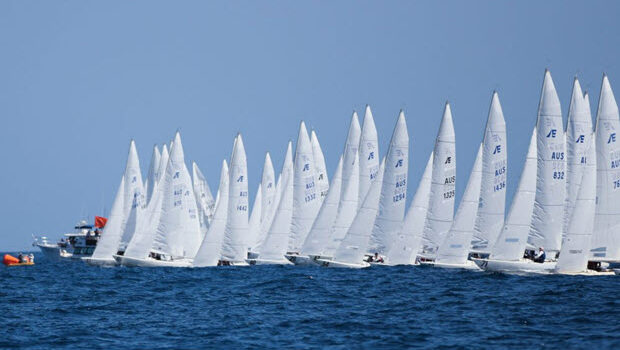Dave Perry’s Playbook: Winning the Middle
Published on December 21st, 2023
In this three part series, Dave Perry discusses the starting options. In Part 3, Dave talks us through how to start in the middle:
“The fastest sailors start in the middle.” “Starting in the middle is more conservative.” “Start in the middle on shifty days.” We’ve heard all the advice…and it’s all good advice. But there are many reasons sailors don’t like starting in the middle of the starting line.
It’s difficult to know where the line is, so often the boats in the middle are several lengths behind the line (called “line sag”). It seems that the boats closer to one end of the line or the other are ahead at the first mark (forgetting to mention that the boats at the “wrong” end of the line are miles behind). And it’s hard to find clear air if you can’t hold your lane after the start.
Here are some tips for starting well in the middle of the starting line.
The most important tool is a great “line sight” or “transit.” Sail towards the RC boat on starboard tack and look through the Pin and see what lines up with the RC boat and Pin on shore. When there are about 30-40 seconds to go before the start, I am usually on starboard tack. That is when I look for my “line sight.”
I might have to pull forward a bit from the boats to leeward of me so I can find my sight. If my sight is well to the left of the Pin, I am well behind the line. If my sight is close to the Pin, I am close to the line. I like to pull the trigger (accelerate) as late as possible so I don’t pull the boats around me forward with me, but I will slowly creep forward watching my sight so I know exactly where the line is.
And when it is time to go, I try always to pull the trigger a little before the boats right to windward and to leeward of me. Generally boats in the middle are not OCS; so it is safe, and really effective, to beat your next door neighbors to the trigger pull.
While waiting on starboard tack to pull the trigger, I try to get as close to the boat to windward of me as possible, even pushing them up above close-hauled, and to get as far away from the boat to leeward of me as possible (called “building a hole”). Having a “hole” to leeward of you before the starting signal allows you to put your bow down (step on the gas pedal) to accelerate so you are at full speed at the gun.
That same hole makes it a whole lot easier to “hold your lane” after the start as well.
Of course, “if you build it, they will come!” While on starboard tack, be sure someone on your boat (you in a singlehanded boat) keeps constantly looking to leeward for incoming port-tack boats looking to tack into your hole, or over your shoulder for incoming starboard-tack boats looking to sail under you and take your hole. The defense for both attacks is to put your bow down when the attacker is about a length away. That may discourage the attackers from trying to tack or sail in to leeward of you.
Once the attackers have sailed past your hole, be uber-aggressive about sailing high back into the upper portion of your hole. You can even go past head to wind to get closer to the boat to windward of you, as long as you keep clear under rule 13, While Tacking, until you’ve turned back down to a close-hauled course on starboard tack.
Dave Perry, an entertaining and educational speaker, is available to share his Playbook and more with clubs and organizations in 2024, either in person or online in a webinar. He can be reached at davperry@optonline.net.









 We’ll keep your information safe.
We’ll keep your information safe.